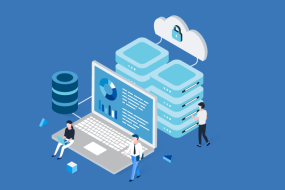
In the ever-evolving digital landscape, the concept of scalability has become paramount. Whether you are a tech enthusiast, an entrepreneur, or a seasoned IT professional, you’ve likely heard the buzz surrounding the term “Scalability.” But what does it mean, and why is it so critical in the cloud computing realm? In this comprehensive blog, we will delve deep into the realm of hyper-scaling in the cloud, exploring the intricate details that define the future of digital infrastructure.
The Essence of Scalability
Scalability, in a nutshell, is the capability of a system or application to handle increasing workloads without compromising performance. It’s the driving force behind the cloud’s remarkable capabilities, offering unparalleled flexibility and adaptability for businesses and individuals alike. As the digital world continues to expand, the importance of scalability cannot be overstated.
Understanding the Demand
In today’s dynamic market, where user demands can surge unexpectedly, scalability becomes a game-changer. Cloud services can dynamically allocate resources, ensuring your application remains responsive under varying loads. This ability to scale up or down on demand is a testament to the cloud’s adaptability.
The Cloud’s Role in Hyper-Scaling
The cloud has revolutionized the way we handle data and applications. With cloud services like Amazon Web Services (AWS), Microsoft Azure, and Google Cloud Platform (GCP), hyper-scaling becomes a reality.
Infrastructure as Code (IaC)
IaC is a pivotal concept in hyper-scaling. It allows you to define your infrastructure using code, enabling automatic scaling based on predefined rules. This level of automation enhances resource allocation and efficiency.
Auto-Scaling
Auto-scaling is a core feature of cloud platforms. It enables your system to adapt to traffic fluctuations automatically. Resource provisioning and de-provisioning become seamless, guaranteeing optimal performance and cost-efficiency.
Scaling Strategies for Success
Successful hyper-scaling involves strategic planning and execution. Here are some essential strategies to consider:
Load Balancing
Load balancing ensures that traffic is evenly distributed across multiple servers, preventing overload on a single server. It is a fundamental aspect of scaling for reliability and performance.
Microservices Architecture
Adopting a microservices architecture enables you to break your application into smaller, independent services. This approach enhances scalability, making it easier to manage and update components.
Serverless Computing
Serverless computing allows you to run code without managing the underlying infrastructure. It’s a cost-effective and scalable approach, as you only pay for the computing resources you consume.
Scalability Best Practices
To ensure the smooth and efficient operation of your scalable system, it’s essential to follow best practices:
Continuous Monitoring
Implement real-time monitoring to track the performance of your system and identify potential issues promptly. Proactive management is key to successful hyper-scaling.
Redundancy and Failover
Plan for redundancy to eliminate single points of failure. This ensures system availability and robustness even under unexpected circumstances.
Cost Optimization
Optimize your cloud resources by periodically reviewing and adjusting your infrastructure. Proper resource allocation can lead to significant cost savings.
Achieving Hyper-Scaling Success
To master the art of hyper-scaling, it’s vital to embrace the cloud’s potential fully. The cloud ecosystem offers a wealth of tools, services, and resources, enabling you to scale your applications and infrastructure effortlessly.
Elasticity and Responsiveness
Scalability and elasticity go hand in hand. Embrace the cloud’s elasticity to adapt to changes in real-time. This responsiveness is what separates traditional IT from cloud computing.
Security and Compliance
Ensure that your hyper-scaled system is secure and compliant with industry standards. The cloud provides robust security measures, but it’s essential to configure them properly.
Future-Proofing
As technology evolves, your scalability strategy should evolve with it. Keep an eye on emerging trends and technologies to stay ahead of the curve.
Final Words
In a world where digital demands are ever-increasing, hyper-scaling in the cloud is the compass pointing toward a future of limitless possibilities. The cloud’s scalability, coupled with strategic planning, is your key to staying ahead in the digital race. Embrace it, master it, and watch your applications soar to new heights.
Commonly Asked Questions
1. What is the primary benefit of scalability in the cloud?
Scalability in the cloud allows your applications to adapt to changing workloads, ensuring optimal performance and cost-efficiency. It’s the key to meeting growing user demands seamlessly.
2. How does auto-scaling work, and why is it crucial?
Auto-scaling is an automated process that adjusts resources based on traffic fluctuations. It ensures that your system remains responsive and cost-effective, making it a fundamental component of successful hyper-scaling.
3. What role does security play in hyper-scaling?
Security is paramount in hyper-scaling. The cloud provides robust security measures, but it’s essential to configure them properly to protect your scalable infrastructure from potential threats.
4. How can I future-proof my scalability strategy?
To future-proof your scalability strategy, stay updated on emerging technologies and trends. Embrace new tools and practices that align with the ever-evolving digital landscape.
5. What’s the difference between elasticity and scalability?
Scalability is the ability to expand or contract resources to meet demand, while elasticity is the real-time adaptability of your system to changes. Elasticity is a crucial component of scalability, enabling responsiveness to dynamic workloads.
Advertisement








